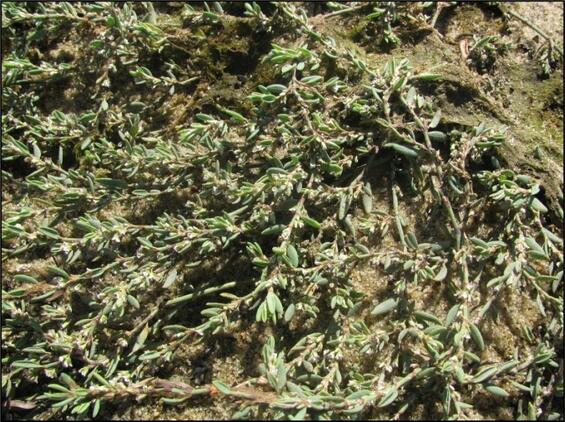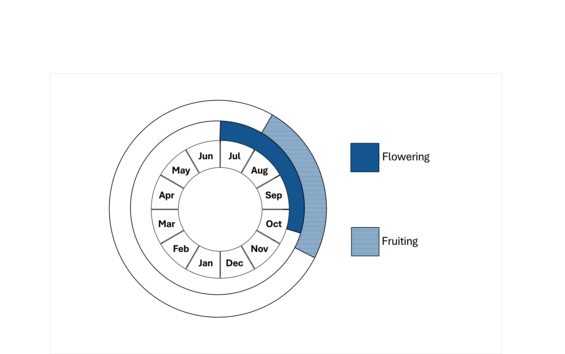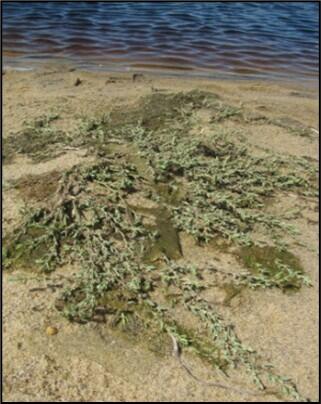- Scientific name: Polygonum glaucum
- Species of Greatest Conservation Need (MA State Wildlife Action Plan)
- Special Concern (MA Endangered Species Act)
Description

Sea-beach knotweed has glaucous leaves with revolute margins. Photo by Jennifer Garrett.
Sea-beach knotweed (Polygonum glaucum) is an annual, prostrate (low-growing) member of the buckwheat family (Polygonaceae). It is found on coastal beaches and on the shores of protected bays and salt ponds. The foliage of sea-beach knotweed is bluish green with a glaucous (waxy coating) appearance for which it is named. The alternate, lanceolate leaves are 10-30 mm (0.39-1.18 in) long, including the petiole, and 2-8 mm (0.08-0.31 in) wide, with revolute margins. The ocrea (tubular stipule typical of the Polygonaceae) at the base of the leaves is 7-10 mm (0.28-0.39 in) long with silvery upper margins. A small inflorescence bears one to several flowers in the leaf axils, protruding slightly from the ocrea. The flower perianth is 3-5 mm (0.12-0.20 in) long and has five spreading, white tepals (petals and sepals that are similar) with white-pink margins. The three-sided achenes (dry, one-seeded fruits) are brownish-black, shiny and smooth, and protrude from the perianth. Sea-beach knotweed produces both summer and autumn fruit; summer fruit are 2.5-3 mm (0.10-0.12 in) long, and autumn fruit are 3-5 mm (0.12-0.20 in) long. Plants grow outward over a sandy substrate throughout the summer and can be 20-70 cm (7.87-27.56 in) in diameter when mature.
The glaucous foliage, prostrate growth habit, and habitat (sandy beaches and salt ponds) can be used to identify sea-beach knotweed in spring and early summer. Reproductive plants with flowers (axillary, white-pink, spreading tepals, 3-5 mm long; 0.12-0.20 in) and fruits (shiny, smooth, brownish-black, 2.5-3 mm in summer; 0.10-0.12 in and 3-5 mm in autumn; 0.12-0.20 in, protruding from the perianth) should be used to confirm identification.
Seaside sandmat (Euphorbia polygonifolia), a prostrate species found in the same habitat as sea-beach knotweed, has opposite leaves that are not glaucous. Knotweed (Polygonum aviculare), an introduced, weedy species found in many disturbed habitats, does not have glaucous foliage and has leaf margins that are not revolute.
Life cycle and behavior
This species is a dynamic annual that may colonize and then disappear from particular locations within a beach system.

Population status
Sea-beach knotweed is listed under the Massachusetts Endangered Species Act as special concern. All listed species are protected from killing, collecting, possessing, or sale, and from activities that would destroy habitat and thus directly or indirectly cause mortality or disrupt critical behaviors. Sea-beach knotweed is found in Bristol, Dukes, and Nantucket Counties. It was also known historically from Barnstable and Suffolk Counties. It has not been found in Plymouth County, but additional surveys are needed. It is found most frequently on Nantucket, where the growing season extends later into the fall and plants are often larger and have more fruits.
Distribution and abundance
Sea-beach knotweed is found in all Atlantic coastal states from Florida to the northern limit of its range in Massachusetts. It is restricted to maritime coastal habitats and is not found inland.

Distribution in Massachusetts. 1999-2024. Based on records in the Natural Heritage Database.
Habitat

Sea-beach knotweed is a low-growing species found on coastal beaches and on the shores of salt ponds. Photo by Jennifer Garrett.
This species is found in maritime beach strand and sub-tidal coastal salt pond communities and may be considered a pioneer species in these dynamic habitats. On beach strands, it is found above the wrack line or high spring tide zone and seaward of dunes and is subjected to storms and over-wash, which may aid in dispersal. It is also found on margins of salt ponds that are closed to tidal effects by sand spits but are occasionally breached by over-wash. In this way seeds may be moved to new locations where it can colonize aggressively. By late summer, the low growing plants may form interwoven “mats” just above the wrack-line. This type of growth habit may provide a temporarily stable environment for seedlings of various beach strand species to become established. Associated species commonly found with sea-beach knotweed include seaside sandmat (Euphorbia polygonifolia), sea-rocket (Cakile edentula), seabeach sandwort (Honckenya peploides ssp. robusta), and seaside goldenrod (Solidago sempervirens). Sea-beach knotweed may also occur with oysterleaf (Mertensia maritima), a species listed as endangered in Massachusetts.
Healthy habitats are vital for supporting native wildlife and plants. Explore habitats and learn about conservation and restoration in Massachusetts.
Threats
Sea-beach knotweed is restricted to coastal habitats where populations are threatened by loss of habitat from natural or anthropogenic disturbances. Populations are best maintained where there are large areas of suitable habitat with intact natural processes. Natural storm and over-wash processes aid in seed dispersal, and construction of jetties or other shoreline stabilization structures may inhibit dispersal. Vehicle traffic, which greatly disturbs beach strand vegetation, may damage populations.
Conservation
Vehicular traffic between the wrack-line and dunes of coastal beach strands and along salt pond margins should be prohibited to provide a protected zone for source populations. Invasive species such as sea poppy (Glaucium flavum) and Asiatic bittersweet (Celastrus orbiculatus) have been documented with this species. Monitoring of populations is needed as sea poppy is a highly aggressive species that can quickly become dominant in these coastal habitats. All active management of rare plant populations (including invasive species removal) is subject to review under the Massachusetts Endangered Species Act and should be planned in close consultation with the MassWildlife’s Natural Heritage & Endangered Species Program.
References
Gleason, H. A., and A. Cronquist. 1991. Manual of Vascular Plants of Northeastern United States and Adjacent Canada, 2nd edition. The New York Botanical Garden, Bronx, NY.
Haines, A. 2011. Flora Novae Angliae – a Manual for the Identification of Native and Naturalized Higher Vascular Plants of New England. New England Wildflower Society, Yale Univ. Press, New Haven, CT.
Contact
| Date published: | May 5, 2025 |
|---|